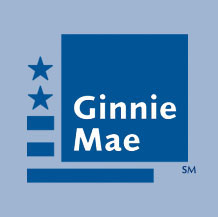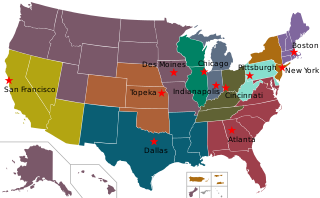Related Research Articles

The Government National Mortgage Association (GNMA), or Ginnie Mae, is a government-owned corporation of the United States Federal Government within the Department of Housing and Urban Development (HUD). It was founded in 1968 and works to expand affordable housing by guaranteeing housing loans (mortgages) thereby lowering financing costs such as interest rates for those loans. It does that through guaranteeing to investors the on-time payment of mortgage-backed securities (MBS) even if homeowners default on the underlying mortgages and the homes are foreclosed upon.

The Federal National Mortgage Association (FNMA), commonly known as Fannie Mae, is a United States government-sponsored enterprise (GSE) and, since 1968, a publicly traded company. Founded in 1938 during the Great Depression as part of the New Deal, the corporation's purpose is to expand the secondary mortgage market by securitizing mortgage loans in the form of mortgage-backed securities (MBS), allowing lenders to reinvest their assets into more lending and in effect increasing the number of lenders in the mortgage market by reducing the reliance on locally based savings and loan associations. Its brother organization is the Federal Home Loan Mortgage Corporation (FHLMC), better known as Freddie Mac.

The Federal Home Loan Mortgage Corporation (FHLMC), commonly known as Freddie Mac, is a publicly traded, government-sponsored enterprise (GSE), headquartered in Tysons, Virginia. The FHLMC was created in 1970 to expand the secondary market for mortgages in the US. Along with its sister organization, the Federal National Mortgage Association, Freddie Mac buys mortgages, pools them, and sells them as a mortgage-backed security (MBS) to private investors on the open market. This secondary mortgage market increases the supply of money available for mortgage lending and increases the money available for new home purchases. The name "Freddie Mac" is a variant of the FHLMC initialism of the company's full name that was adopted officially for ease of identification.

The Federal Home Loan Banks are 11 U.S. government-sponsored banks that provide liquidity to financial institutions to support housing finance and community investment.
A government-sponsored enterprise (GSE) is a type of financial services corporation created by the United States Congress. Their intended function is to enhance the flow of credit to targeted sectors of the economy, to make those segments of the capital market more efficient and transparent, and to reduce the risk to investors and other suppliers of capital. The desired effect of the GSEs is to enhance the availability and reduce the cost of credit to the targeted borrowing sectors primarily by reducing the risk of capital losses to investors: agriculture, home finance and education. Well known GSEs are the Federal National Mortgage Association, known as Fannie Mae, and the Federal Home Loan Mortgage Corporation, or Freddie Mac.
In the United States, a jumbo mortgage is a mortgage loan that may have high credit quality, but is in an amount above conventional conforming loan limits. This standard is set by the two government-sponsored enterprises (GSE), Fannie Mae and Freddie Mac, and sets the limit on the maximum value of any individual mortgage they will purchase from a lender. Fannie Mae (FNMA) and Freddie Mac (FHLMC) are large agencies that purchase the bulk of U.S. residential mortgages from banks and other lenders, allowing them to free up liquidity to lend more mortgages. When FNMA and FHLMC limits don't cover the full loan amount, the loan is referred to as a "jumbo mortgage". Traditionally, the interest rates on jumbo mortgages are higher than for conforming mortgages, however with GSE fees increasing, Jumbo loans have recently seen lower interest rates than conforming loans.

A house price index (HPI) measures the price changes of residential housing as a percentage change from some specific start date. Methodologies commonly used to calculate an HPI are hedonic regression (HR), simple moving average (SMA), and repeat-sales regression (RSR).
In the United States, a super jumbo mortgage is a jumbo mortgage that far exceeds the conforming loan limits. These are typically 4 times the maximum loan amount set by Fannie Mae or Freddie Mac which as of 2024 was $766,551. A super jumbo mortgage would be a mortgage greater than $3 million, although lenders differ on just what constitutes a super jumbo mortgage subject to their own internal investment criteria.
A non-conforming mortgage is a term in the United States for a residential mortgage that does not conform to the loan purchasing guidelines set by the Federal National Mortgage Association /Federal Home Loan Mortgage Corporation. Mortgages which are non-conforming because they have a dollar amount over the purchasing limit set by FNMA/FHLMC are often called "jumbo" mortgages. Mortgages which are non-conforming because they do not meet FNMA/FHLMC underwriting guidelines are sometimes mistakenly called "subprime" mortgages. Non-conforming loans must remain in a lender's portfolio, or be sold to other companies who purchase non-conforming loans, or be securitized, with the securities being sold to investors seeking non-conforming mortgage-backed securities. Consequently, a premium is paid by those obtaining non-conforming mortgages, generally .25 or .5 points more than the same loan would cost if it were conforming. The loan amount is adjusted every few years depending upon the average sales price of homes in the U.S.
An Alt-A mortgage, short for Alternative A-paper, is a type of U.S. mortgage that, for various reasons, is considered riskier than A-paper, or "prime", and less risky than "subprime," the riskiest category. For these reasons, as well as in some cases their size, Alt-A loans are not eligible for purchase by Fannie Mae or Freddie Mac. Alt-A interest rates, which are determined by credit risk, therefore tend to be between those of prime and subprime home loans, although there is no single accepted definition of Alt-A. Typically Alt-A mortgages are characterized by borrowers with less than full documentation, average credit scores, higher loan-to-values, and more investment properties and secondary homes. A-minus is related to Alt-A, with some lenders categorizing them the same, but A-minus is traditionally defined as mortgage borrowers with a FICO score of below 680 while Alt-A is traditionally defined as loans lacking full documentation. Alt-A mortgages may have excellent credit but may not meet underwriting criteria for other reasons. During the past decade, a significant amount of Alt-A mortgages resulted from refinancings, rather than property purchases.

The United States Housing and Economic Recovery Act of 2008 was designed primarily to address the subprime mortgage crisis. It authorized the Federal Housing Administration to guarantee up to $300 billion in new 30-year fixed rate mortgages for subprime borrowers if lenders wrote down principal loan balances to 90 percent of current appraisal value. It was intended to restore confidence in Fannie Mae and Freddie Mac by strengthening regulations and injecting capital into the two large U.S. suppliers of mortgage funding. States are authorized to refinance subprime loans using mortgage revenue bonds. Enactment of the Act led to the government conservatorship of Fannie Mae and Freddie Mac.

The Federal Housing Finance Agency (FHFA) is an independent federal agency in the United States created as the successor regulatory agency of the Federal Housing Finance Board (FHFB), the Office of Federal Housing Enterprise Oversight (OFHEO), and the U.S. Department of Housing and Urban Development government-sponsored enterprise mission team, absorbing the powers and regulatory authority of both entities, with expanded legal and regulatory authority, including the ability to place government-sponsored enterprises (GSEs) into receivership or conservatorship.

In September 2008, the Federal Housing Finance Agency (FHFA) announced that it would take over the Federal National Mortgage Association and the Federal Home Loan Mortgage Corporation. Both government-sponsored enterprises, which finance home mortgages in the United States by issuing bonds, had become illiquid as the market for those bonds collapsed in the subprime mortgage crisis. The FHFA established conservatorships in which each enterprise's management works under the FHFA's direction to reduce losses and to develop a new operating structure that will allow a return to self-management.
James B. Lockhart III is an American U.S. Navy officer, business executive, and, since September 2009, Vice Chairman of WL Ross & Co, which manages $9 billion of private equity investments, a hedge fund and a Mortgage Recovery Fund. It is a subsidiary of Invesco, a Fortune 500 investment management firm. He coordinates WL Ross's investments in financial services firms and mortgages. Lockhart serves co-chairs the Bipartisan Policy Center's Commission on Retirement Security and Personal Savings.
Loan modification is the systematic alteration of mortgage loan agreements that help those having problems making the payments by reducing interest rates, monthly payments or principal balances. Lending institutions could make one or more of these changes to relieve financial pressure on borrowers to prevent the condition of foreclosure. Loan modifications have been practiced in the United States since the 1930s. During the Great Depression, loan modification programs took place at the state level in an effort to reduce levels of loan foreclosures.

The mortgage industry of the United States is a major financial sector. The federal government created several programs, or government sponsored entities, to foster mortgage lending, construction and encourage home ownership. These programs include the Government National Mortgage Association, the Federal National Mortgage Association and the Federal Home Loan Mortgage Corporation.
The Home Affordable Refinance Program (HARP) is a federal program of the United States, set up by the Federal Housing Finance Agency in March 2009, to help underwater and near-underwater homeowners refinance their mortgages. Unlike the Home Affordable Modification Program (HAMP), which assists homeowners who are in danger of foreclosure, this program benefits homeowners whose mortgage payments are current, but who cannot refinance due to dropping home prices in the wake of the U.S. housing market correction.

People of the State of California v. Federal Housing Finance Agency was a California state case in which several California-based plaintiffs filed suit against the Federal Housing Finance Agency (FHFA) for creating a lending rule that impeded the Property Assessed Clean Energy (PACE) program, a program in which property owners repay energy-related property improvements gradually over time as an addition to their property tax.

The Budget and Accounting Transparency Act of 2014 is a bill that would modify the budgetary treatment of federal credit programs. The bill would require that the cost of direct loans or loan guarantees be recognized in the federal budget on a fair-value basis using guidelines set forth by the Financial Accounting Standards Board. The bill would also require the federal budget to reflect the net impact of programs administered by Fannie Mae and Freddie Mac. The changes made by the bill would mean that Fannie Mae and Freddie Mac were counted on the budget instead of considered separately and would mean that the debt of those two programs would be included in the national debt. These programs themselves would not be changed, but how they are accounted for in the United States federal budget would be. The goal of the bill is to improve the accuracy of how some programs are accounted for in the federal budget.
Collins v. Yellen, 594 U.S. ___ (2021), was a United States Supreme Court case dealing with the structure of the Federal Housing Finance Agency (FHFA). The case follows on the Court's prior ruling in Seila Law LLC v. Consumer Financial Protection Bureau, which found that the establishing structure of the Consumer Financial Protection Bureau (CFPB), with a single director who could only be removed from office "for cause", violated the separation of powers; the FHFA shares a similar structure as the CFPB. The case extends the legal challenge to the federal takeover of Fannie Mae and Freddie Mac in 2008.
References
- 1 2 3 Wiedemer, John (2001). Real Estate Finance, 8th Edition. Prentice Hall. pp. 44, 78–86. ISBN 978-0-324-18142-5.
- 1 2 "FHFA Announces Maximum Conforming Loan Limits for 2024". Federal Housing Finance Agency. 30 November 2023. Retrieved 30 November 2023.
- ↑ "Mortgage Tools - Conforming Loan Limits". Zillow. Retrieved 21 September 2013.
- ↑ "Conforming Loan Limits | Federal Housing Finance Agency".
- ↑ "Addendum - Calculation of 2022 Conforming Loan Limits under HERA | Federal Housing Finance Agency" (PDF).
- ↑ "2006 Loan limits". Fannie Mae. February 7, 2006. Archived from the original on February 7, 2006.
- ↑ Bush, House Hammer Out $150 Billion Stimulus Bill(2008), Washington Post
- ↑ Annual Report to Congress - 2020, Federal Housing Finance Agency, Last updated 2021-06-15. (.pdf, see table 24 on page 129)
- ↑ Fannie Mae and Freddie Mac Conforming Loan Limits for Mortgages Acquired in Calendar Year 2022 and Originated after 10/1/2011 or before 7/1/2007, Federal Housing Finance Agency, Last updated 2021-11-30.